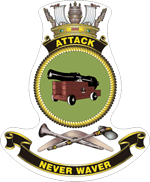 HMAS Attack (second from right) with three other Attack-class patrol boats | |
| History | |
|---|---|
| Builder | Evans Deakin and Company |
| Launched | 8 April 1967 |
| Commissioned | 17 November 1967 |
| Decommissioned | 21 February 1985 |
| Motto | "Never Waver" |
| Fate | Sold to Indonesia |
| Badge |  |
| Name | Sikuda |
| Acquired | 24 May 1985 |
| Status | Active as of 2011 |
| General characteristics | |
| Class & type | Attack-class patrol boat |
| Displacement |
|
| Length | 107.6 ft (32.8 m) length overall |
| Beam | 20 ft (6.1 m) |
| Draught |
|
| Propulsion |
|
| Speed | 24 knots (44 km/h; 28 mph) |
| Range | 1,200 nmi (2,200 km; 1,400 mi) at 13 knots (24 km/h; 15 mph) |
| Complement | 3 officers, 16 sailors |
| Armament |
|
HMAS Attack (P 90) was the lead ship of the Attack-class patrol boats used by the Royal Australian Navy (RAN). Launched in April 1967 and commissioned in November that year, the ship was largely commercial in design and was used to protect fisheries in Australia's northern waters, and to support the survey ship Moresby. The vessel remained in RAN service until 1985 when it was transferred to the Indonesian Navy and renamed Sikuda.